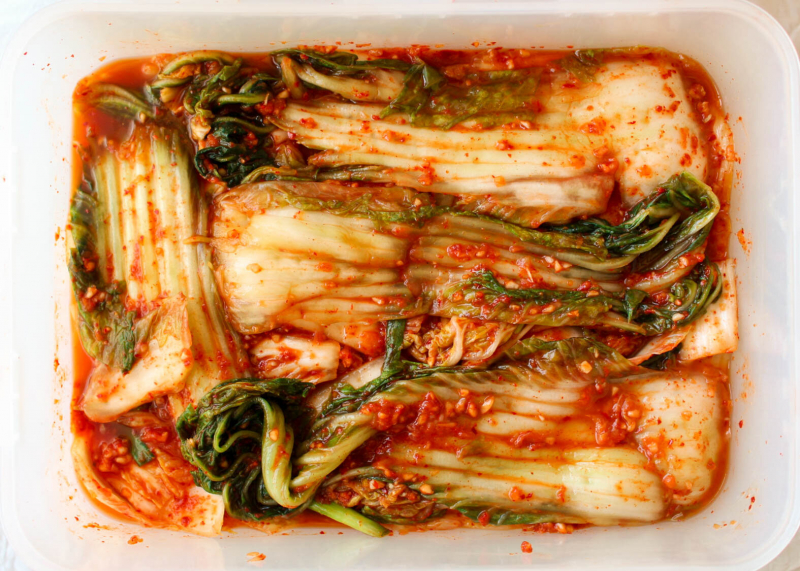Kimchi
This traditional Korean cuisine dates back to the Shilla Dynasty and has been around for almost 2,000 years. Kimchi is made by fermenting Korean cabbage, radish, pumpkin, onion, ginger, and scallion with chili powder, crushed garlic, and salty fish. This traditional food, which comes in over 200 varieties in Seoul, is eaten on its own or with white rice, and is also used in porridges, soups, and rice cakes. Kimchi is also used to make kimchi stew (kimchi jjigae), kimchi pancake (kimchijeon), and kimchi fried rice, among other meals.
Ingredients
- 1 medium head napa cabbage (about 2 pounds)
- 1/4 cup iodine-free sea salt or kosher salt (see Recipe Notes)
- Water, preferably distilled or filtered
- 1 tablespoon grated garlic (5 to 6 cloves)
- 1 teaspoon grated peeled fresh ginger
- 1 teaspoon granulated sugar
- 2 tablepoons fish sauce or salted shrimp paste, or 3 tablespoons water
- 1 to 5 tablespoons Korean red pepper flakes (gochugaru)
- 8 ounces Korean radish or daikon radish, peeled and cut into matchsticks
- 4 medium scallions, trimmed and cut into 1-inch pieces
Instructions
- Cut the cabbage into small pieces. Quarter the cabbage by cutting it lengthwise through the stalk. Remove the cores from each of the pieces. Cut each quarter into 2-inch-wide strips crosswise.
- Season the cabbage with salt. Sprinkle the salt over the cabbage in a large mixing dish. Massage the salt into the cabbage with your hands until it softens a little. Cover the cabbage with enough water to keep it submerged. Place a plate on top of the cabbage and weigh it down with a heavy object, such as a jar or a can of beans. Allow for 1 to 2 hours of resting time.
- Clean the cabbage by rinsing it and draining it. Rinse the cabbage three times in cool water. Allow 15 to 20 minutes to drain in a colander. Make the spice paste in the meantime.
- Make a paste with the spices. The bowl you used for salting should be rinsed and dried. To make a smooth paste, combine the garlic, ginger, sugar, fish sauce, shrimp paste, or water. Set aside until the cabbage is cooked, stirring in the gochugaru, using 1 tablespoon for mild and up to 5 teaspoons for spicy (I like approximately 3 1/2 tbsp).
- Combine the veggies and spice paste in a mixing bowl. Squeeze out any excess liquid from the cabbage and toss it in with the spice paste. Combine the radish and scallions in a mixing bowl.
- Make a thorough mix. Gently mix the paste into the veggies with your hands until they are well covered. Gloves are not required, however they are strongly suggested to protect your hands from stings, stains, and odors!
- Fill the container halfway with kimchi. Fill a 1-quart container halfway with kimchi. Press the kimchi down until the brine (the liquid that comes out) rises to cover the veggies, leaving at least 1 inch of room at the top. Close the jar.
- Allow 1 to 5 days for fermentation. Put a basin or plate underneath the jar to catch any spills. Allow 1 to 5 days for the jar to sit at room temperature, out of direct sunlight. Inside the jar, bubbles may appear, and brine may seep out of the lid.
- Check it every day and refrigerate it when it's done. Once a day, open the jar and gently press down on the veggies with a clean finger or spoon to keep them buried in the brine. (Gase generated during fermentation is also released.) At this stage, try a little bit of everything! Transfer the container to the refrigerator when the kimchi is mature enough to your liking. You can eat it right immediately, but it'll taste best in a week or two.












